Aberdeen defeated Spartans 4-0 in professional fashion on Saturday in the Quarter-Finals of the Premier Sports Cup. They will now play Celtic in the semi-finals. As is now obligatory to note, this makes it 11 wins from 11 for the season. Six out of six in this competition.
Though the ever-humble and ever-professional Bo Jimmy Thelin would never countenance such a possibility, the game was essentially a competitive training session that allowed the Swede to give the players more time to develop on-field relationships and playing patterns. He did not deviate from the 4-2-3-1 at any point, in a game where he may have been expected to field more strikers. Leighton Clarkson and Ante Palaversa got a full 90. Kevin Nisbet got another hour and another goal, and we saw Pape Gueye on the right.
Spartans put up a valiant fight, keeping a compact block. Their midfielders and forwards worked their socks off to make things as difficult as possible. For Aberdeen it presented a consistent environment (with limited opposing attacking threat) for them to repeatedly attack a deep-lying low block.
Why worry about a low block?
In the lead up to Jimmy Thelin’s arrival, podcasts, tweets and newspaper articles sought insight from Elfsborg experts on how that team played, and subsequently what we might expect at Aberdeen. The prevailing feedback can be generally summed up by quotes from Sean Wallace’s piece (behind a paywall) in the P&J from late May.
“With the low block strategy, Elfsborg normally focus on protecting their defensive third of the pitch. They are extremely tight in a deep position, defending the area close to goal. Thelin adopts the same counter-attack philosophy with Elfsborg set up to soak up the pressure with minimum damage before hitting back at the optimum moment. When the time is right, bang, Elfsborg hit with a rapid counter-attack that leaves opponents reeling.”
Though the possession stats support this to some element it is not completely conclusive. Elfsborg’s season possession averages were 45.5% in 2021, 48.3% in 2022 and 46.5% in 2023. An average of 46.7%. Indeed in the game that Mr. Wallace attended, he noted that Thelin had changed his normal strategy based on the opponent adopting a similar plan.
Whilst there’s no suggestion this feedback from Elfsborg-related sources is incorrect and I certainly don’t have the time to go back and watch the 2023 Allsvenskan campaign to disprove it, the question has always been (for me at least) what would happen when opponents set up to contain, particularly at Pittodrie. As we’ve seen so far this season, this may well be the case, most weeks. The Dons are at 55.9% average possession in SPFL. Playing on the counter-attack, just might not be an option.
Thelin himself has only said that he has a desire to “to overload the opposition’s penalty box.” But how do you overload a box when the whole opposition is in there? Just ask Pep Guardiola how hard that can be.
This is why Saturday was a good study as it gives us some ideas on how Aberdeen may try to do it in future. Conveniently, reviewing all four goals provides an avenue to touch on four different scenarios.
Note: There is less data available from League Cup games, so the chances identified are from my own notes. I may well have missed a couple or got a couple of pass totals wrong. You can see the list I collated of chances created at the bottom of the article.
Goal #1 Ball Recovery
I’m not certain if this is the correct term within the analytics community and these two may be one of the same thing, or at least there’s shades of gray, but anyway, for the purposes of this review, I’ve separated ball recoveries and counter pressing. The former relate to picking up a loose ball from a clearance the latter, referring to an obvious effort to win the ball back quickly after a turnover.
Prior to the opening goal there was a great chance for Nisbet on six minutes which maybe shows this better. The ball had gone wide from a corner and Palaversa positioned himself at the edge of the box to pick up the loose ball. Being frank, this is something most intelligent players would do and with six Spartan’s players on the six yard line, it’s not a surprise that he and Nilsen have plenty of room. Think of corners, free-kicks and goal-kicks all in this same ballpark.
Palaversa lays the ball off to Nilsen who scoops the ball in behind for Nisbet who should really score but hits straight at the Spartans keeper.
Six minutes later Aberdeen do score in similar fashion. I’m not certain screenshots are completely necessary but as you’ll see from the highlights below, Palaversa is situated on the edge of the box from a corner. His half-volley ricochets out to Pape who slams home. Staying alive in these situations after a cross is played in to keep the play going after an initial clearance to hit shots, clever through passes and crosses all may be future avenues to score goals.
It’s not to say that this is rocket science or groundbreaking, but if the question is how do we get through the packed defence then this is one method. In Palaversa we now have someone, who can leather it, if it pops out, we have players to challenge in the air and we have good delivery from wide areas.
Goal #2: Counter Pressing
Nisbet’s goal shows the hunger to win a ball back and quickly exploit a defense not ready and not in position. The Spartans player has to control a tricky headed pass/clearance on his chest. Clarkson is tight behind, McGrath ready in front.
He takes a heavy touch and McGrath is able to win the ball back. The opposition defence gets briefly attracted to the ball in the aftermath and McGrath (showing great strength, close control and composure) is able to play a through ball to MacKenzie while Nisbet makes his move into the box.
Nisbet in the middle has managed to get in a position on the blindside of the defender and MacKenzie, is able to provide the delivery for the loanee to tap in. In just a quick period, the well-organised Spartan’s defence has allowed a ball in behind and is not aware of the whereabouts of the Aberdeen forwards.
Incidentally this move started with a floated pass from deep from Nilsen. It might be giving credit where none is due, but I do wonder if it was possibly intended to draw the Spartan’s back-line out a bit. Maybe it was just a crap pass.
The main takeaway here is the mentality of the players to win the ball back and quickly get the ball forward. It took two passes and five seconds to hit the back of the net. I haven’t really focused too much on this aspect of the team so far this season but I only expect this will become more apparent in our upcoming fixtures, starting at Dens this Saturday.
There were two other good instances of this earlier in the half as well when Nisbet missed the ball completely on 18 minutes and McGrath had a volley that went wide (featured in the link to highlights above).
Goal #3: Accurate Long Passes
The second period was barely alive when the Dons went ahead courtesy of the boot of Slobodan Rubezic and the head of Leighton Clarkson. Yes, you might be right, Thelin IS a magician. Rubezic’s deep cross/long pass (take your pick) came at the end on an extended passing sequence, which was more of the theme after the interval.
As we can see the entire Spartan’s team is pretty much behind the ball and Rubezic is in possession about 35 yards from goal. Is this likely to be a regular occurence? Probably not but he may well be on the ball a little further back.
In terms of the original point, on breaking down the packed defense, we have a high commitment of numbers stretching the Spartan’s backline which creates the gaps for Clarkson to drift in between the defenders. The right back is concerned about a potential run from MacKenzie and out of shot is Devlin who is occupying the left midfielder.
That the pass is played from this position just allows a bit more space to exploit in behind. MacKenzie would have been an alternative option with the diagonal to attack himself or knock across goal. It’s just another example of Thelin being willing to push players on to create his ‘overloads in the box’.
Additionally, as teams look to reduce Nilsen, Shinnie and now Palaversa’s influence, Molloy and the big Montenegrin will likely see more of the ball. The former (another assured game) seems comfortable on the ball, the latter less so. I think Ross County were quite happy for Rubezic to have the ball a few weeks back and he gave the ball away a number of times when presented with limited options to find a close teammate. However, we saw here, and later on with the fourth goal, a composure and technique to find an area or a player in the air over distance. Long may it continue.
The long passes, we were told, were a trademark of Thelin’s style at Elfsborg and we also saw some snippets of what Palaversa is able to do in that area. It was was pretty impressive.
Goal #4: Patient Passing, Overloads and a wee bit of Craft
Rumours that the ball has finally rolled over the goal-line after Ester Sokler’s ‘shot’ are unconfirmed but hopefully this ends up being the Slovenian’s confidence-boosting ‘one in, off the backside.’
This goal, showed how you can unbalance a team. With a long passing sequence, Aberdeen were able to position players into areas, knowing there was a good chance the ball would not be lost (same on the third goal). Once the long diagonal was played, the movements were very quick to exploit the overload
Leighton' Clarkson’s return added more technique further up the pitch and he combined well with McGrath, Nilsen and MacKenzie. He often drifted wide to the left interchanging with McGrath, picking up from where he left off in the league cup games. Jamie and Jack are developing a great partnership, but adding Clarkson, I think, takes it up a notch. The two attacking midfielders, are so intelligent with their off the ball movement, can connect little one-two’s, play in tight spaces and deliver a killer ball in behind. It goes without saying, this will be vital in breaking down defences moving forward.
At this point, for the fourth goal, McGrath was moved out to the right and Keskinen to the left, but Clarkson was continually moving into that space as the Finn positioned himself more centrally. As Rubezic picks up the ball after an extended period of possession, all three are positioned on the left side, creating an overload.
As Clarkson receives, MacKenzie is already on his bike (Jack’s performances this season need a post of their own to be honest). Most of the game he was receiving on the outside but this time we have an underlapping run. It’s hard to imagine this is not a pattern or ‘principle’ that is being worked on in training. We’ve seen it a number of times this season.
Clarkson has that ability to thread the ball through the eye of the needle, or in this case, the defenders legs, setting MacKenzie up for the cross. Again he shows a maturity, technically and tactically, to find Sokler for the simplest and slowest of tap-ins. Improved delivery in these areas has been a hallmark of Thelinball.
In conclusion with this goal, we see the importance of movement, overloads, and a quick change of tempo to get in behind the low block.
Scoring Chance Summary
For those who may like to watch again, here’s my summary of the scoring chances we created.
Conclusion
These games are always tricky to draw major conclusions from and I don’t expect that Aberdeen will have it quite so much their way again for a full 90. But, at the very least, as we saw at Dingwall or at home to Queen’s Park, there will be points in games when teams do park the bus and I don’t think if St Mirren, Kilmarnock or Motherwell had gone ahead in the home matches, they would have pushed for a second.
As said previously, possession does not always lead to scoring chances, but there was enough variety in Aberdeen’s play, enough attempts to find different solutions, that can give optimism. Patience will be important. As the third and fourth goals showed, sometimes extended passing sequences can be used to setup attacking overloads in other areas to be exploited when the time comes. Clarkson returning is a big plus.
Some other quick notes:
Central Midfield battle: Yep I don’t know either what Jimmy will do. Nilsen gets a rest on Saturday, my guess.
Keskinen: Poorest appearance so far. Dribbling in tight spaces not his forte. Will need time.
Sokler: More intense presser than Nisbet. Might be the horse for some future courses.
To the left, to the left, everything thing, in an attack to the left. MacKenzie and McGrath both deserve International call-ups. Probably won’t get them. Not the end of the world for Aberdeen.
I’ll be back at the end of the week for a preview of the Dundee match. In the meantime, enjoy your week and another win.
Stay humble.


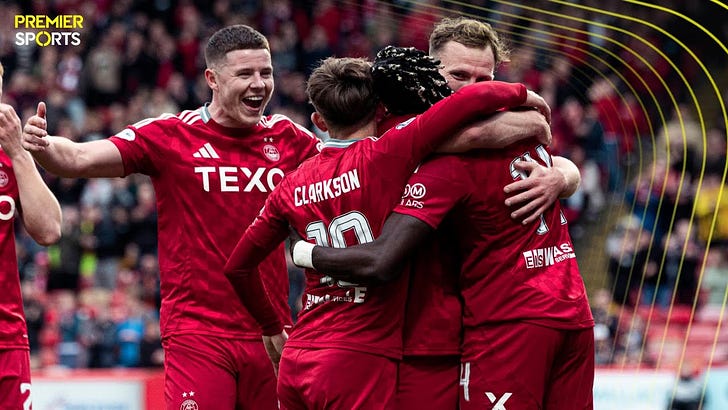


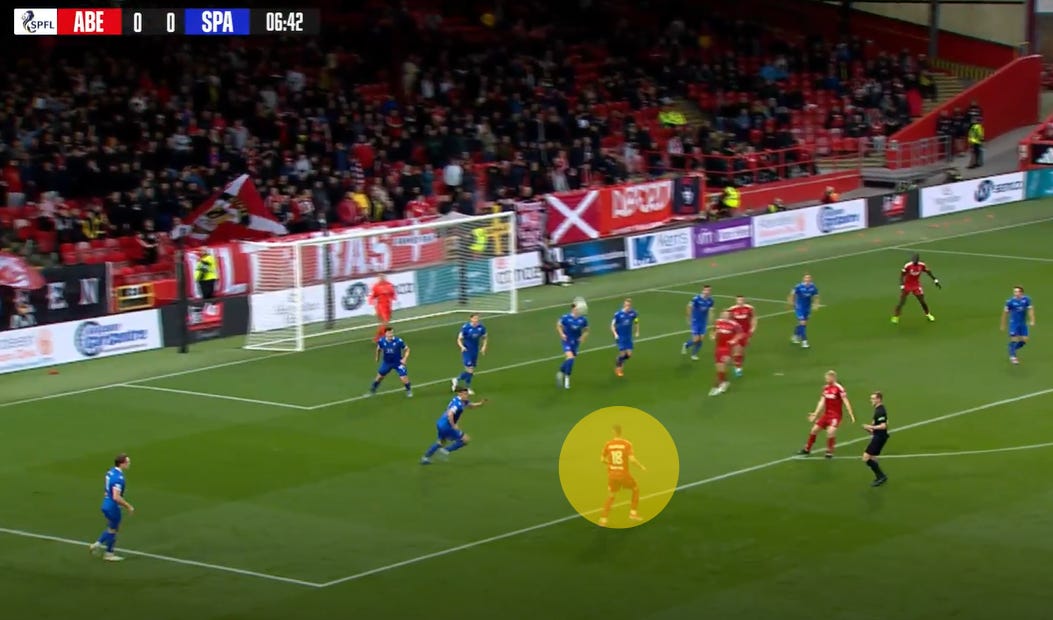
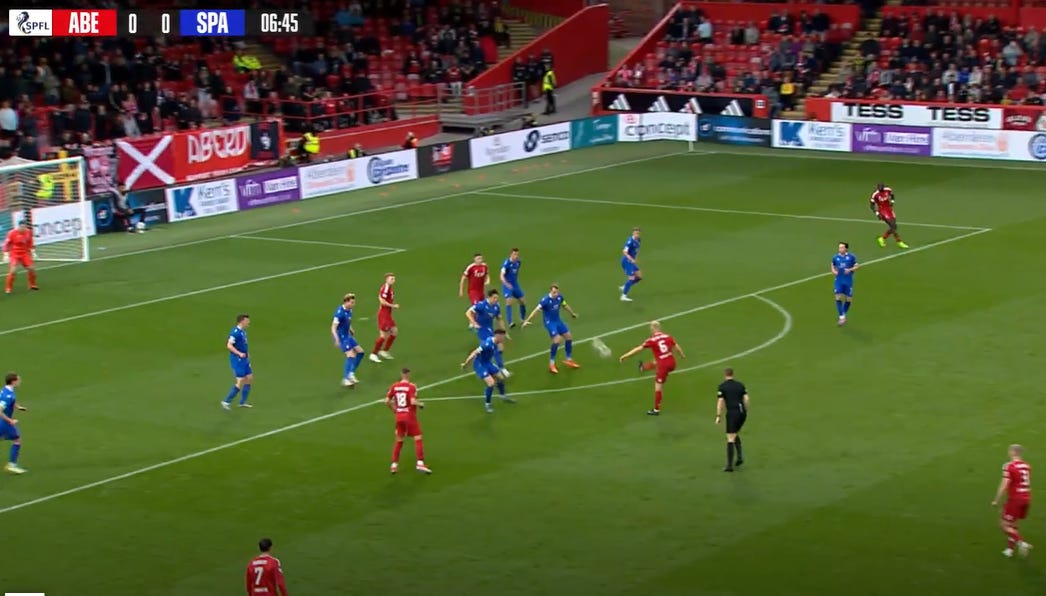
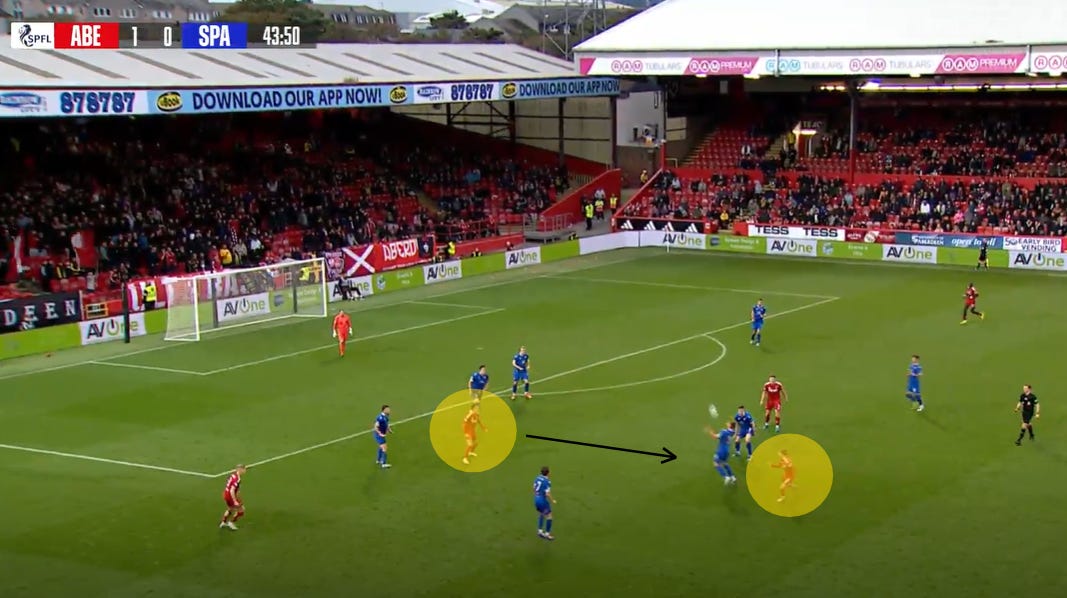
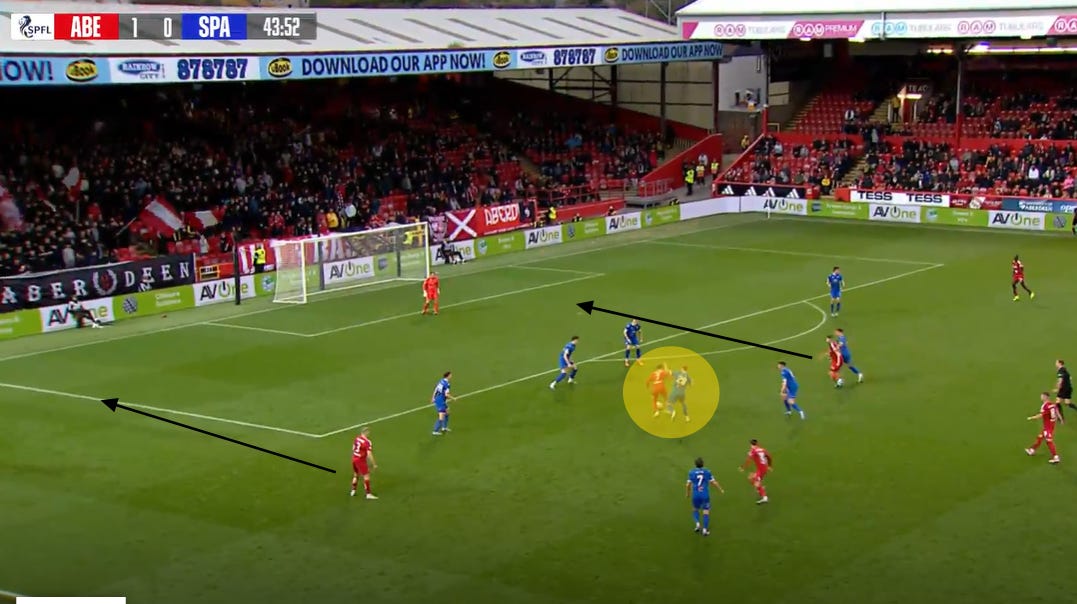

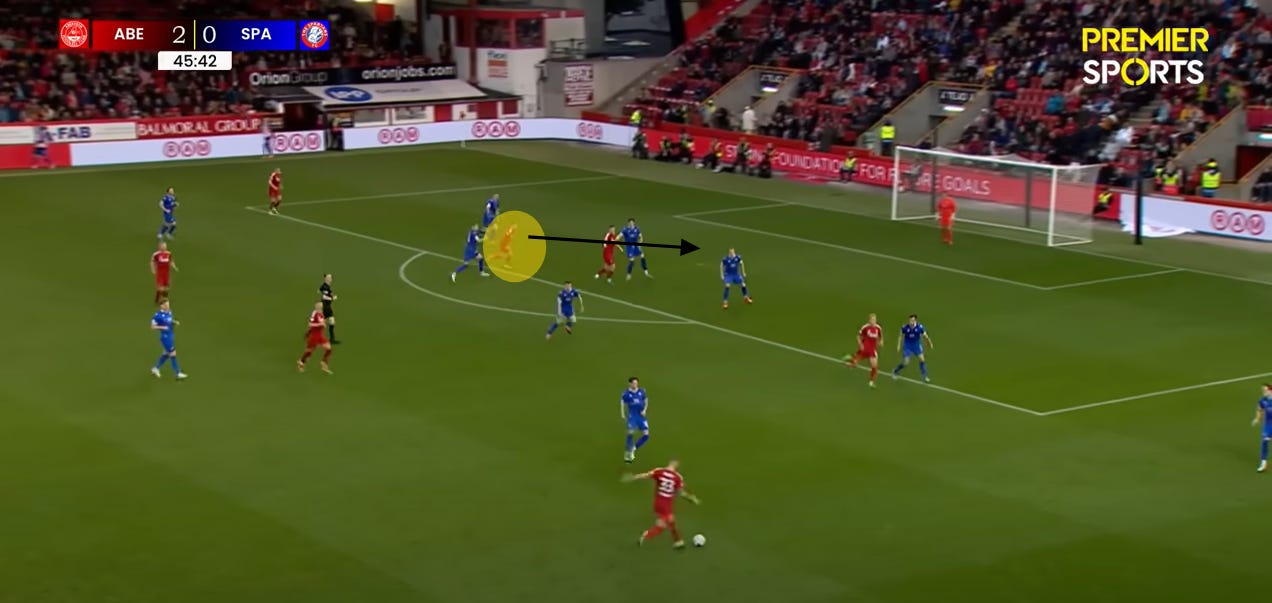
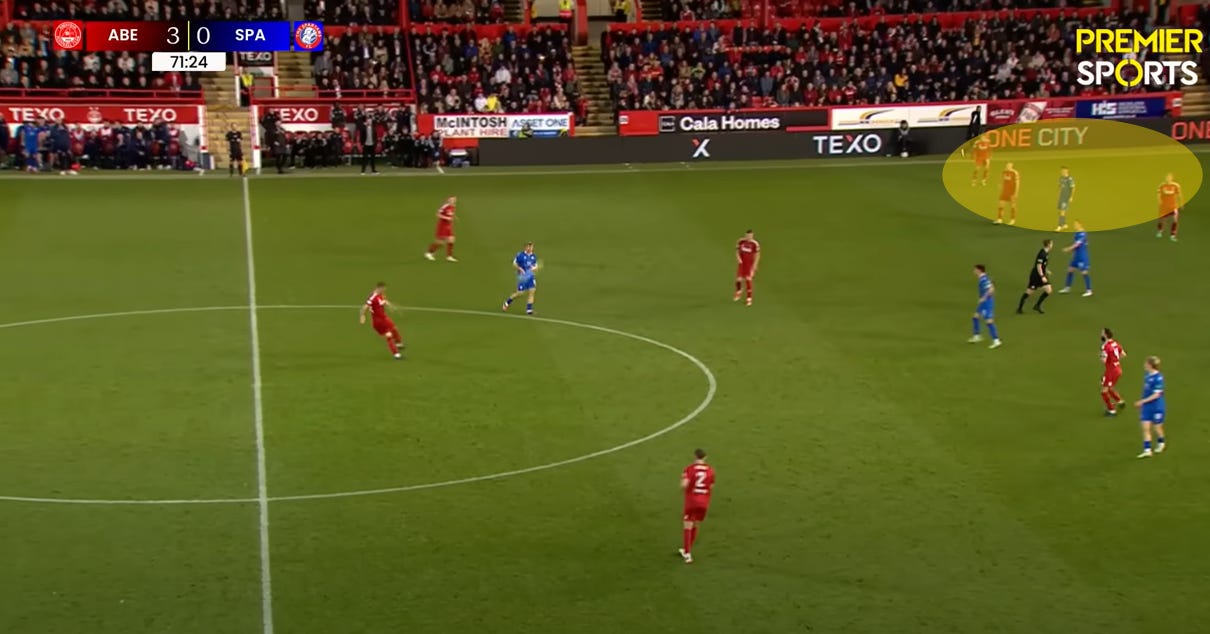
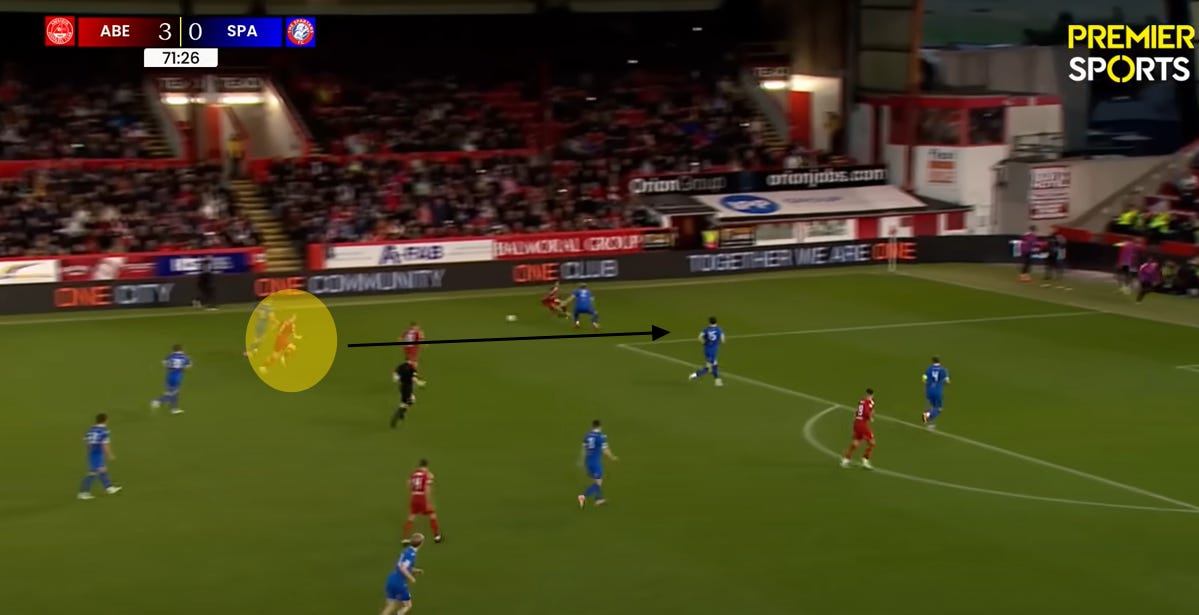
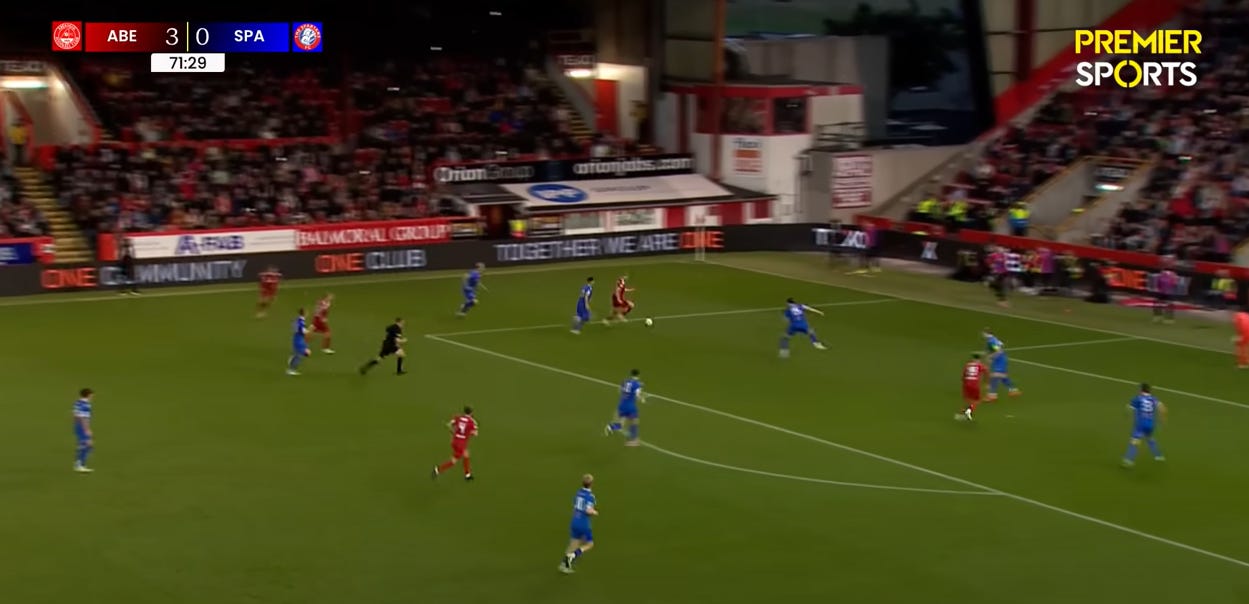
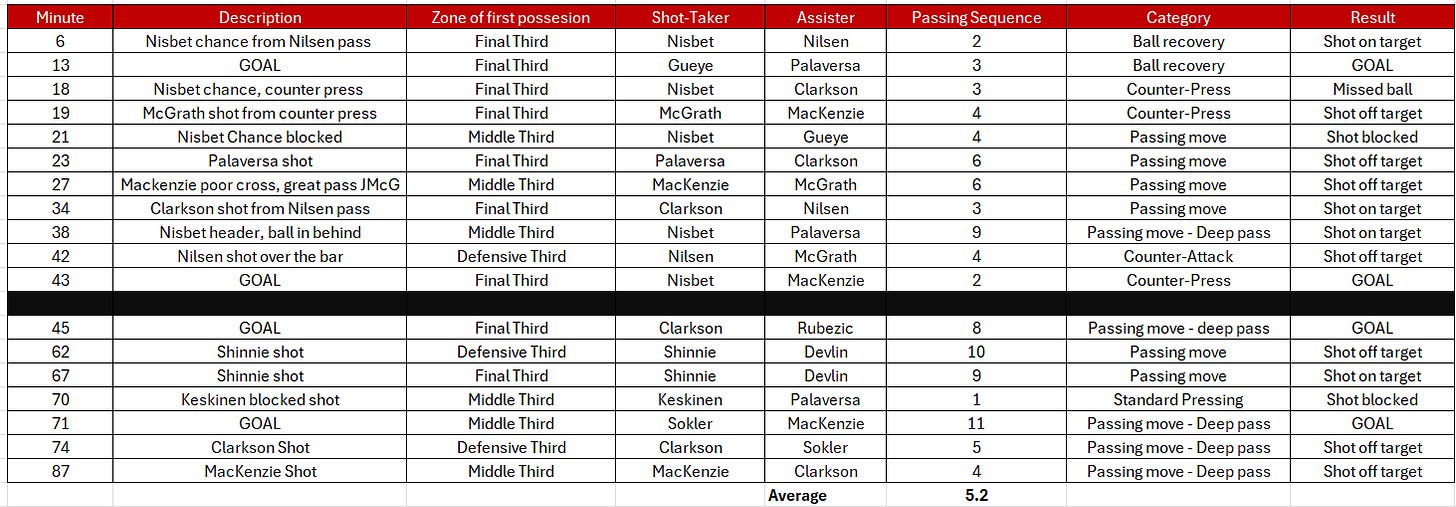
Thanks for pointing that out. On my list to take a bigger look at the set-pieces. I did think he might want to keep players up for counter attacks but maybe the clean sheet was priority at that point and as you say he likes everyone moving in the same direction.
Thanks for the feedback. COYR
Great write up.
One thing I noticed was Spartans got a corner in the 89th minute and despite being 4 up we still packed all 11 players in the box, not leaving a man at the halfway line.
I had a little grumble about it at the time but then remembered Thelin talking about being a solid block and attacking as one, defending. as one.
Glad we're thru to Hampden and looking forward to playing Celtic in the Semi's.